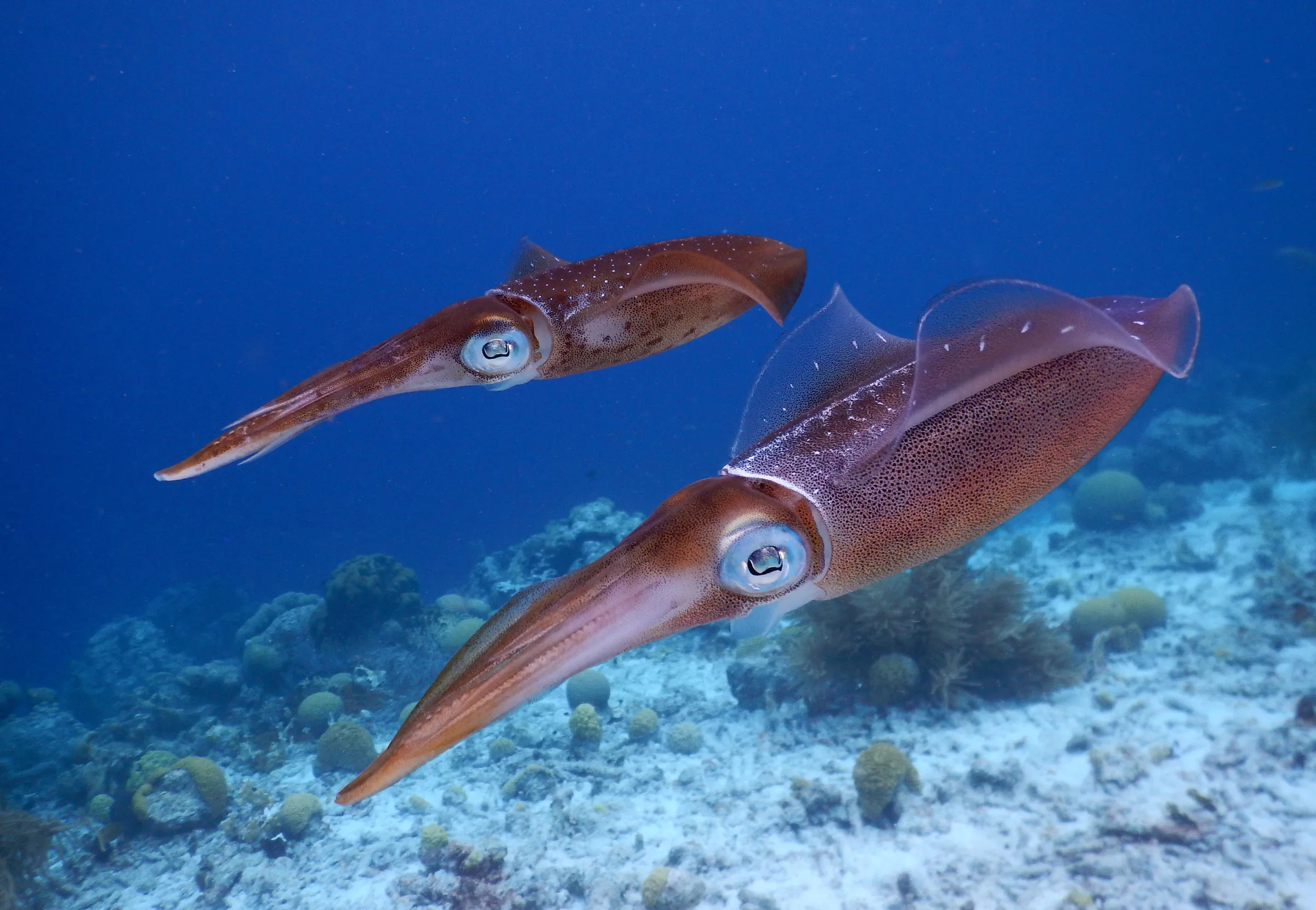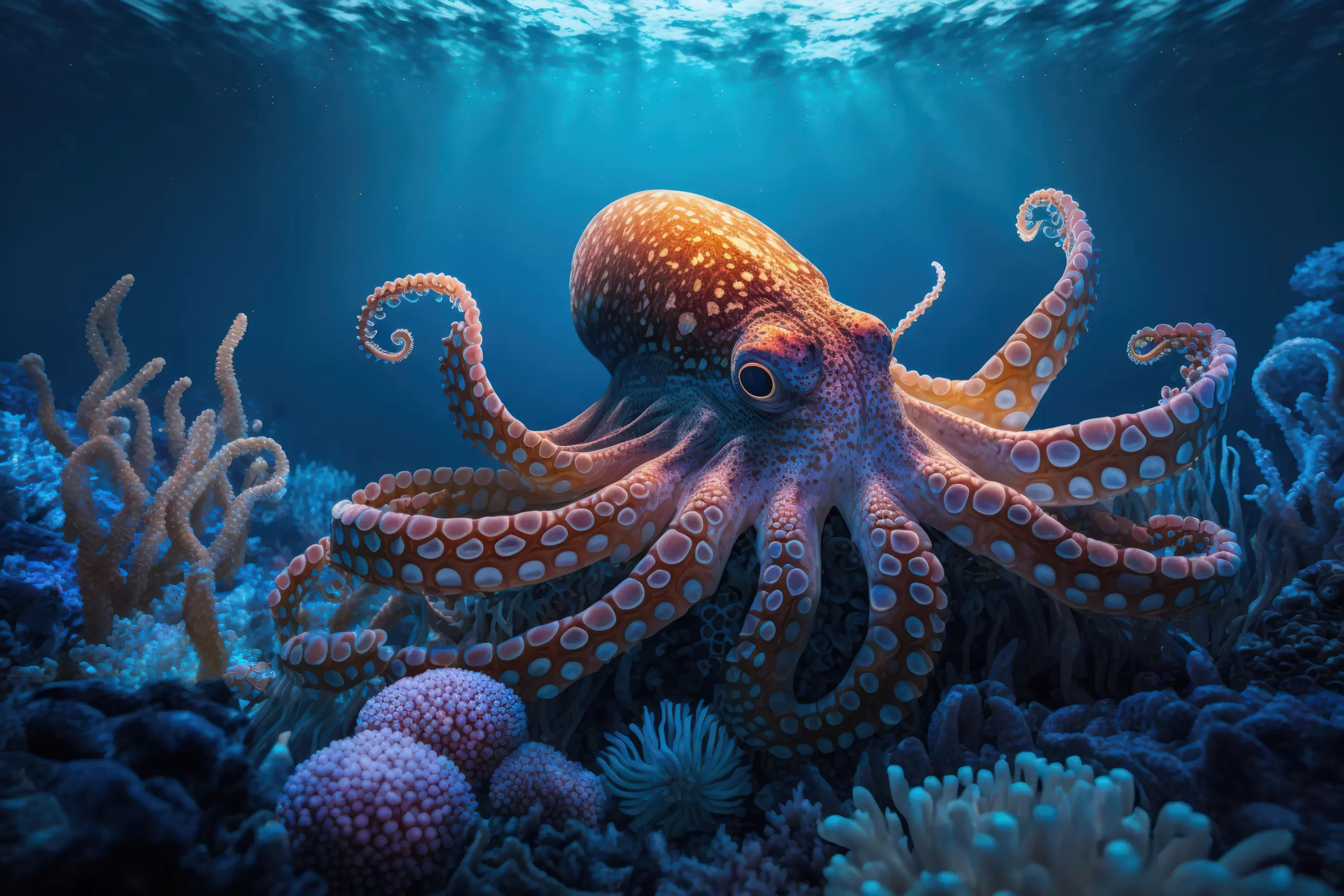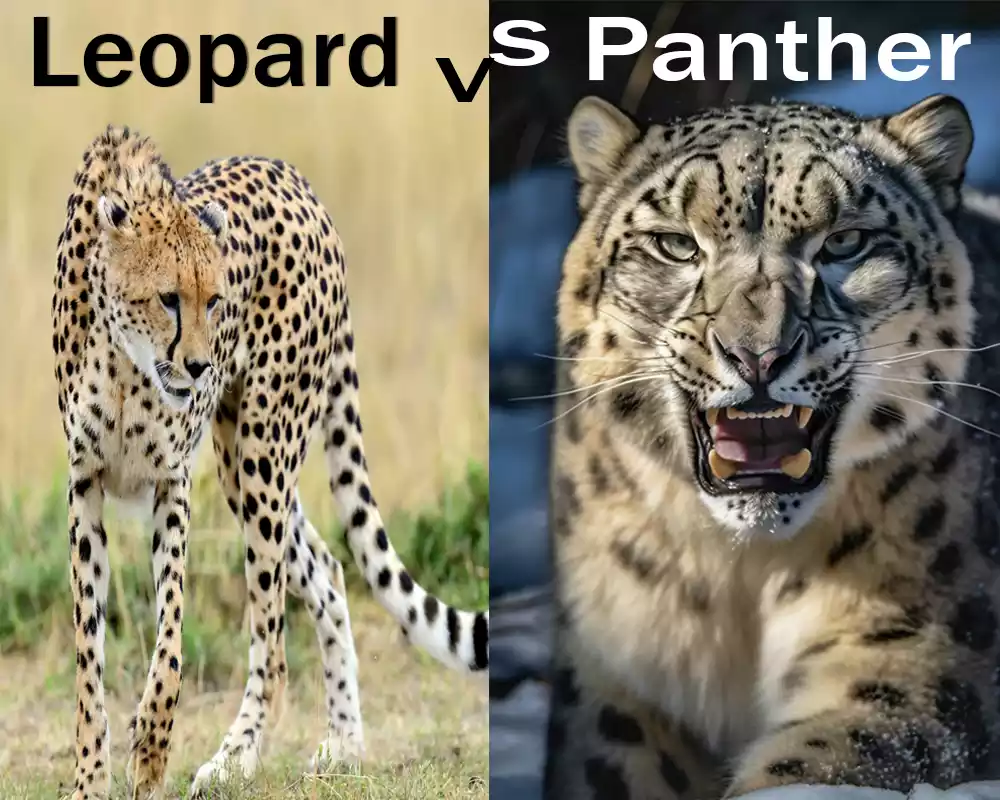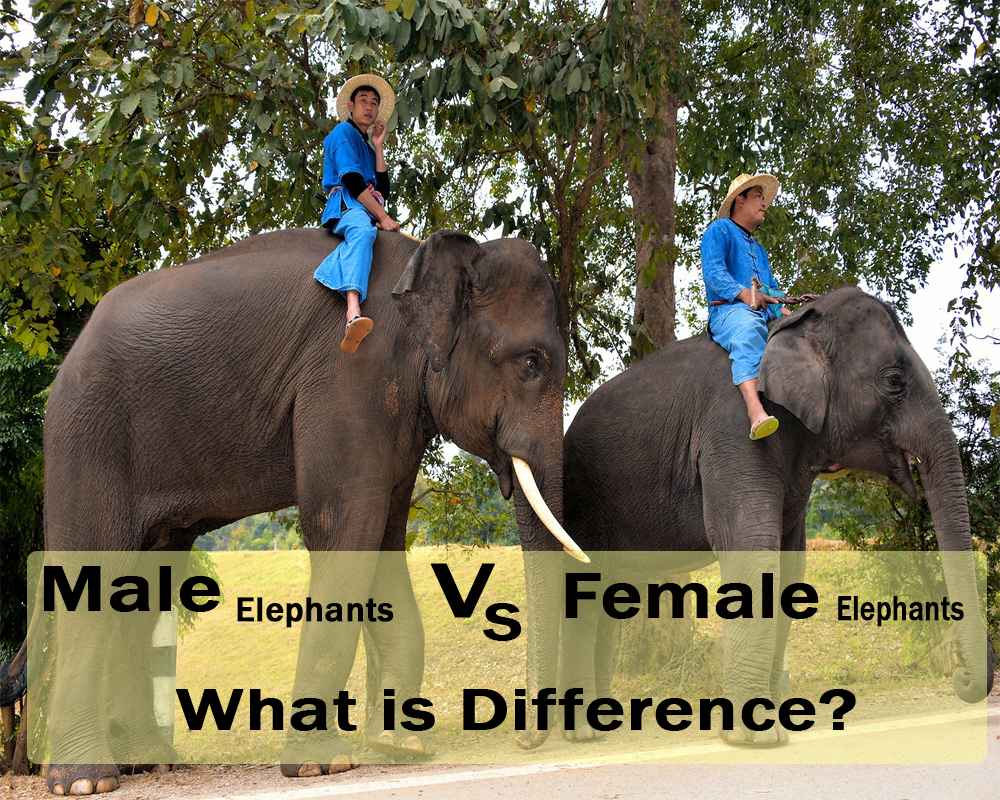Introduction of Squid vs Octopus
Squids and octopuses are both intriguing cephalopods, yet they differ notably in anatomy and behavior. Squids have elongated bodies with fins and move predominantly by jet propulsion, featuring eight arms and two additional longer tentacles for capturing prey. Typically found in open water, they can range greatly in size. Octopuses, on the other hand, are known for their rounded, sack-like bodies and exclusively have eight arms with suction cups.
They exhibit a more versatile movement, primarily crawling along the sea floor, and are celebrated for their intelligence and camouflage abilities. While both share features like ink sacs and developed eyes, their distinct habitats and behaviors underscore the diversity within the cephalopod family.
Definition of Squid
A squid is a marine cephalopod mollusk characterized by a distinct head, bilateral body symmetry, a mantle, and the presence of eight arms and two longer tentacles. These creatures are notable for their fast and agile swimming capabilities, enabled by jet propulsion through expelling water from a siphon. Squids vary greatly in size, with some species reaching over 12 meters in length.

They are predominantly carnivorous, feeding on fish, smaller cephalopods, and other marine organisms. Squids possess an ink sac for defense, and many species can change color for camouflage or communication. They inhabit a range of marine environments, from shallow coastal waters to the deep sea, and play important ecological and economic roles in marine ecosystems.
Definition of Octopus
An octopus is a marine cephalopod mollusk characterized by its rounded body, bulging eyes, and eight distinctive arms lined with suction cups. Unlike squids, octopuses do not have any additional tentacles. These creatures are known for their remarkable intelligence, their ability to change skin color and texture for camouflage, and their unique method of locomotion, which primarily involves crawling along the sea floor using their arms.

Octopuses can also swim by expelling water from a siphon for jet propulsion. They are generally solitary creatures, often found in dens or hiding spots within the ocean’s rocky crevices. Octopuses are carnivorous, feeding mainly on crustaceans, mollusks, and fish. They are found in various marine environments, from shallow coastal waters to the deep sea, and are known for their problem-solving skills and complex behaviors.
Importance of understanding their differences
Understanding the differences between squids and octopuses is important for several reasons, spanning from ecological and biological research to fisheries management and even educational outreach:
- Ecological Impact: Squids and octopuses occupy different ecological niches and play distinct roles in marine ecosystems. Understanding their behaviors and interactions with other species is crucial for studying marine biodiversity and ecosystem health.
- Biological Research: These creatures exhibit unique adaptations and biological traits. Studying their differences enhances our understanding of cephalopod biology, including aspects like neural function, camouflage, and jet propulsion. This research can inspire biomimetic designs in technology and contribute to advancements in neuroscience and robotics.
- Conservation Efforts: Knowledge of their habitats, life cycles, and environmental needs is essential for conservation strategies. Different threats may affect squids and octopuses differently, so tailored conservation approaches are necessary.
- Fisheries Management: Both squids and octopuses are commercially important. Understanding their life histories and population dynamics is vital for sustainable fisheries management and to mitigate overfishing.
- Public Education and Awareness: Educating the public about these fascinating creatures can foster appreciation and support for marine life conservation. Understanding their differences can also dispel misconceptions and promote interest in marine biology.
- Medical and Pharmaceutical Research: Studying their unique physiological characteristics can lead to medical advancements. For example, octopus skin has inspired research in adaptive materials, and cephalopod neurobiology has potential implications for neuroscience.
- Climate Change Research: As sentinel species, changes in their populations can indicate shifts in oceanic conditions due to climate change. Understanding their specific ecological requirements helps in assessing the impacts of environmental changes.
Recognizing and understanding the differences between squids and octopuses is essential for a comprehensive understanding of marine life, contributing to various fields such as ecology, technology, conservation, and education.
Comparison table of Squid vs Octopus
Certainly! Here’s a comparison table outlining the key differences between squids vs octopuses:
| Feature | Squid | Octopus |
| Body Shape | Elongated with a more streamlined shape | Rounded, sack-like body |
| Size | Varies, from small to very large (e.g., giant squid) | Varies, generally smaller than large squids |
| Fins | Often have fins on their head for stability and motion | Lack fins |
| Arms and Tentacles | Eight arms and two longer tentacles | Eight arms, no additional tentacles |
| Movement | Primarily moved by jet propulsion, swimming in open water | Crawl along the sea floor, can swim using jet propulsion |
| Habitat | Mostly found in open water, various depths | Prefer the sea floor, often near coasts and in reefs |
| Diet | Carnivorous, feeding on fish, other cephalopods, etc. | Carnivorous, feeding on crustaceans, mollusks, etc. |
| Camouflage | Some species can change color | Known for exceptional camouflage abilities |
| Intelligence | Less studied, but show learning abilities | Highly intelligent, known for problem-solving skills |
| Social Behavior | Typically more solitary, some species form shoals | Solitary, territorial |
| Defense Mechanism | Ink sac for defense | Ink sac, and some species can detach limbs (autotomy) |
| Commercial Value | Important in fisheries for food and products | Also fished, but less extensively than squids |
This table highlights the general characteristics of each group, but it’s important to note that there is considerable diversity within each category, with many species exhibiting unique traits and behaviors.
Physical Characteristics
When discussing the physical characteristics of squids and octopuses, both belong to the class Cephalopoda and share some common features, but they also have distinct differences:
Squid
- Body Shape: Squids have a more elongated, torpedo-shaped body, which is streamlined for fast swimming.
- Size: They vary significantly in size, with some species like the giant squid reaching lengths of over 12 meters.
- Fins: Many squid species have fins on their head, which aid in their movement and stability in water.
- Arms and Tentacles: Squids possess eight arms and two additional longer tentacles, used primarily for capturing prey.
- Movement: They are known for their ability to move quickly through the water using jet propulsion, expelling water from a siphon.
- Skin and Coloration: Squids can change color thanks to chromatophores in their skin, aiding in camouflage and communication.
- Eyes: Generally, squids have large, well-developed eyes, which are crucial for their predatory lifestyle.
Octopus
- Body Shape: Octopuses have a more rounded, sack-like body with no rigid structure.
- Size: They also vary in size, but generally, octopuses are smaller than the largest squids.
- Arms: Octopuses have eight arms equipped with suction cups along their entire length, but no additional tentacles.
- Movement: Octopuses are more benthic, often crawling along the sea floor, but they can also swim using jet propulsion.
- Camouflage: Known for their extraordinary ability to change both color and texture for camouflage and signaling.
- Intelligence: Octopuses are highly intelligent, demonstrating advanced problem-solving and learning capabilities.
- Defense Mechanisms: Besides releasing ink, some octopuses can perform autotomy (detach a limb) to evade predators.
Squids and octopuses have an ink sac for defense, a beak-like jaw for feeding, and complex nervous systems. They are fascinating creatures, each adapted to their unique lifestyles within the marine environment.
Habitat and Range
The habitat and range of squids and octopuses vary significantly, reflecting their adaptations to different environments within the marine world.
Squid
- Habitat: Squids are predominantly found in open waters, though some species inhabit nearshore areas. They can be found at various depths, from shallow coastal waters to the deep sea.
- Range: Squids have a global distribution, inhabiting all the world’s oceans. Their range includes both tropical and temperate waters, extending to the deep sea.
- Migration: Some species of squid are known for their extensive migrations, often related to breeding or feeding patterns.
Octopus
- Habitat: Octopuses typically prefer the sea floor, where they find shelter in crevices, caves, and under rocks. Some species inhabit coral reefs, while others are adapted to pelagic (open ocean) or even abyssal (deep-sea) environments.
- Range: Like squids, octopuses are found in oceans worldwide, from the Arctic and Antarctic regions to tropical waters. Their range is diverse, covering various marine environments.
- Territorial Behavior: Many octopus species are known to be territorial, maintaining a specific den or area as their home base and hunting ground.
Both squids and octopuses have adapted to a wide range of marine environments, showcasing their incredible versatility and ability to thrive in different oceanic conditions. Their presence in diverse habitats highlights the adaptability and resilience of cephalopods as a group.
Diet and Feeding Habits
The diet and feeding habits of squids and octopuses reflect their roles as efficient predators in the marine ecosystem, each adapted to their specific environments.
Squid
- Diet: Squids are carnivorous, primarily feeding on fish, smaller cephalopods, crustaceans, and other marine organisms.
- Feeding Strategy: They are active predators. Many use their two longer tentacles to snatch prey and bring it to their mouths.
- Hunting: Squids often hunt in open water, using their speed and agility. Some species can also exhibit cooperative hunting behavior.
Octopus
- Diet: Octopuses also have a carnivorous diet, mainly consuming crustaceans, mollusks (like clams and snails), and small fish.
- Feeding Strategy: They use their arms and suction cups to capture prey, often using their ability to camouflage and ambush unsuspecting prey.
- Hunting: Octopuses are generally solitary hunters, relying on stealth and their ability to blend into the environment. They can also use tools, like rocks to crack open hard-shelled prey.
Squids and octopuses have beak-like jaws which they use to break down their food. Their feeding habits not only highlight their roles as predators but also their adaptability and intelligence, especially in the case of octopuses, known for their problem-solving skills in obtaining food. These habits are crucial for maintaining the balance in their respective marine environments.
Life Cycle and Reproduction
The life cycles and reproductive strategies of squids and octopuses are fascinating and distinct, showcasing the diversity within cephalopods.
Squid
- Life Cycle: Squids generally have a short life span, often just one to two years. This varies among species.
- Reproduction: Squids usually engage in a mass spawning event. Males deposit spermatophores (sperm packets) into the mantle cavity of females.
- Egg Laying: Females lay eggs in clusters or strings, which they attach to a substrate or let float freely, depending on the species.
- Development: Squid embryos develop inside the eggs and hatch as miniature versions of adults, bypassing a larval stage. They grow rapidly, reaching maturity quickly.
Octopus
- Life Cycle: Octopuses also tend to have short lifespans, ranging from as little as six months to up to five years in larger species.
- Reproduction: Males use a specialized arm called a hectocotylus to transfer sperm to the female. In some species, the arm is detached and given to the female.
- Egg Laying: Females lay eggs in a den or safe hiding place. The number of eggs can range from a few dozen to hundreds of thousands, depending on the species.
- Parental Care: Unlike squids, female octopuses often exhibit extensive parental care, guarding and cleaning the eggs until they hatch. The female usually dies soon after the eggs hatch.
- Development: Similar to squids, octopus hatchlings emerge as miniature adults, forgoing a larval stage. They often start life in a planktonic stage before settling to the bottom as they mature.
Squids and octopuses exhibit semelparity, meaning they reproduce once and then die. Their life cycles are marked by rapid growth, a short period of reproductive capability, and subsequent death. This reproductive strategy is quite different from many other marine organisms and is a key aspect of their ecological roles.
Social Behavior
Squids and octopuses exhibit distinct social behaviors, reflective of their ecological niches and evolutionary adaptations.
Squid
- Social Interaction: Squids can display varying degrees of social behavior. Some species are quite solitary, while others, like certain shoaling squids, exhibit more social interaction, especially during feeding or spawning.
- Communication: Squids communicate through a variety of means, including changing their skin color and patterns. This is used for signaling during social interactions, mating displays, and as a form of camouflage.
- Mating Behavior: In many species, mating involves complex rituals, often with males competing for females. In some cases, males may guard females after mating.
Octopus
- Social Interaction: Octopuses are generally solitary creatures. Most species lead a predominantly isolated life, coming together only for mating purposes.
- Territoriality: Many octopus species are territorial, maintaining and defending a specific den or area as their home base. They usually hunt and live within this territory.
- Mating Behavior: Octopus mating is typically a solitary event, and there is little to no social bonding. The male often uses a specialized arm to transfer sperm and then leaves. In some species, this process can be quite perilous for the male.
Conclusion
Squids and Octopuses are fascinating and distinct members of the cephalopod family. Squids, with their elongated bodies, fins, and additional tentacles, are adapted for a life predominantly in open water, showcasing remarkable speed and agility. They often exhibit varying degrees of social behavior, particularly during spawning. Octopuses, known for their rounded, flexible bodies and lack of fins, are more benthic, leading a solitary life marked by incredible intelligence and camouflage abilities.
While both share common cephalopod traits like ink sacs and complex nervous systems, their differences in physical characteristics, habitat preferences, and social behaviors highlight the diverse adaptations within the cephalopod class, each uniquely suited to their respective environments in the marine world.


